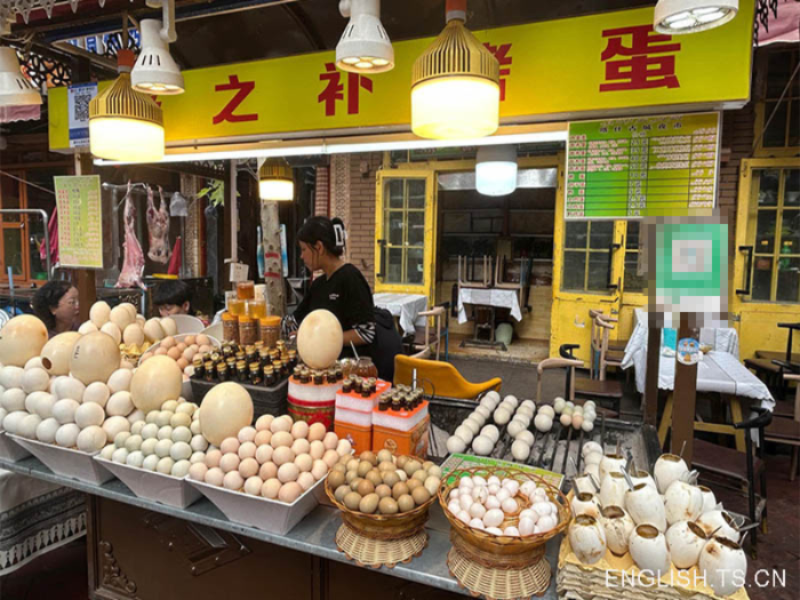Xinjiang, which occupies one third of China’s land area, is actually a “distant and unknown” area for many Chinese people. However, this is a province with most beautiful ladies, friendly men and lively places that people from every corner from the world to discover its extraordinary charm. With a chance of a week-long “One Belt, One Road” trip to the region, here are some interesting points that I would like to share with all readers.
When the plane was about to land at Kashi airport, I could no longer hold my joy and excitement. Although the view outside from the window was already dark, I still cannot help to admire the scenery. Xinjiang has 20 national-level first-class ports and neighbors eight countries. It has been an important political and military position on the “Silk Road” since Western Han Dynasty (202BC to 8).

Photo shows a vender's stand in Kashi, northwest China's Xinjiang Uygur Autonomous Region.
Flying to Kashi is feeling more like flying with an international flight because the duration without counting transit hours in Chengdu is nearly eight hours and a half from Hangzhou, a city just held the best amazing Asian Games 2023. It says the direct flight from Shenzhen to Kashi launched by China Southern Airlines in the past few months has been listed so far as the longest route in China.
Upon the arrival at the hotel, I quickly ran to the 24-hour convenience store “Daily and Nightly” adjacent to the hotel, feeling the name “day and night” equally meaning “sleepless” for this city: the grilling smoke and constant yelling for selling local specialties like kebabs on the street, paired with local Wusu beer brewed from wheat or rye, or Xinjiang’s home-brewed red wine with rich fruity aroma. Initially, I wanted to purchase a bottle of local wine to experience the taste, finally decided to buy a bottle of milk to help sleep earlier. To my amazement, “extra thickness” of milk texture made me with suspicion of “concentrated milk,” but looking at the packaging written with “100 percent fresh & natural product” explains there is still a quality difference even though with the same brand but produced at different places — water, air, glass and natural environment. Xinjiang is just a land proved to be a “blessed paradise for fruit, vegetables and dairy products.”
The next morning, I purposely woke up earlier in order to explore the neighborhood further through ordinary people’s morning routine. I witnessed Xinjiang people on the roadside casually eating standard breakfast: chose of 1-2 pieces from more than 50 kinds of dazzling nang bread, dipped in “condensed” milk or salty milk tea and then sprinkling some nuts on the top. If still hungry, add some fragrant roasted lamb meat. I was strongly required to sip some coffee to balance my exhaustion from last night. Holding the cup with closer “inspection,” I found a few rose paddles and raisins floating in the coffee to enhance the flavor. I inquired a local friend why the coffee smelt not only a bit fruity but also with touch of flowers and plants. He explained that it was because an herbaceous plant called “Uygur medicine” was added for its uniqueness.

Photo shows Ye Lu in Tianchi scenic area in northwest China's Xinjiang Uygur Autonomous Region.
One night, I looked for some snacks on the roadside with my colleagues. When I saw a can of craft beer, I immediately bought a glass for the taste, but found that it tasted very sweet. I was told that actually it is honey sparkling water, and contains 3 percent alcohol.
Watching people at another table sipping Xinjiang’s home-brewed wine, it’s hard to imagine that just a few decades ago, Xinjiang was partially a barren and waterless Gobi Desert. Through local people’s unconditional “Ke Ke Ya” spirit, they managed to overcome the harsh natural environment, gaining a “cradle of fruits” or “hometown of vegetables” nickname in China today. The unique temperature difference between day and night also creates natural and unique conditions for the production of sweet grapes as well, and the rich and fruity Xinjiang wine perhaps is one of unknown secrets in the world!
Before traveling to Xinjiang, I was worried about lack of oxygen, but I was told that Xinjiang is different from Xizang. The higher the altitude, the more negative oxygen ions there are. One cubic centimeter contains more than 10,000 negative oxygen ions, so feel free to breathe in the “natural oxygen bar” in Xinjiang. I was very intoxicated when I listened to two old Uygurs playing Rewap, a century-old local music instrument, at a traditional teahouse. After listening to it, I realized that the two were also in an invisible “fight” during the playing and singing. They would win only when the other party ran out of words.
Xinjiang, a region just like a maze of alleys, continues to write 99 amazing stories in 99 alleys to Chinese, as well as to foreign tourists through flower pots, ironware, medicine, hats, fruits, vegetables, music and smiles in the bazar.
(Ye Lu is a Chinese living in Indonesia. She is a journalist at International Daily, Indonesia.)
Planner : Jie Wenjin
Reviewers : Hou Weili and Cheng Li









